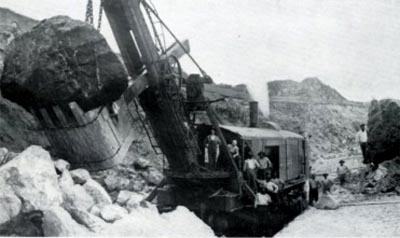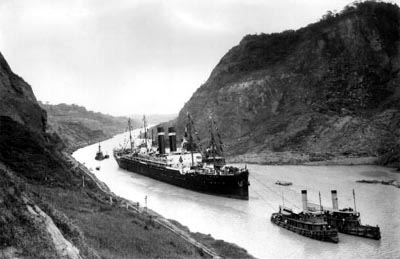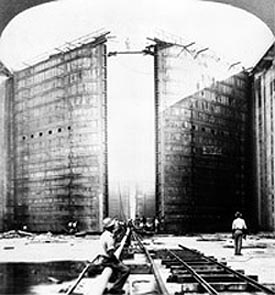 |
Connecting
the Pacific and the Atlantic:
The
Panama Canal
|
|

A
ship enters the Miraflores Lock while passing through
the canal.
|
Charles the 5th, the Holy Roman Emperor and King
of Spain, had a problem. A few years before in 1532 Francisco
Pizarro, a Spanish conquistador, had defeated and captured the
Inca Empire in Peru. The mines of that country were now producing
a wealth in silver to be sent back to Spain, but the trip required
ships to travel thousands of miles all the way around the tip
of South America before they could make their way eastward across
the Atlantic Ocean to Europe. The king pondered if perhaps there
wasn't a better way.
In 1513 Vasco Nuņez de Balboa had discovered that
in Central America there was just a narrow strip of land, not
much more than 50 miles (80km) wide, separating the Atlantic
from the Pacific Ocean. Suppose a canal could be dug through
that strip of land? It would not only shorten the trip from
Peru for the Spanish vessels, it would give Spain a tactical
military advantage against its rival in the new world, Portugal.
Though the distance was only fifty miles it was
one of the most difficult landscapes imaginable to work in combining
dense jungles with steep mountains. King Charles ordered the
Panama regional governor to survey the area for a canal following
the route of the Chagres River. The governor came to the conclusion,
however, that building such a passageway through the rugged
terrain would be impossible.
|
Seven
Quick Facts
|
| -Length:
48 miles (77 km) |
| -Maximum
water height above sea level: 85 feet (26m) |
| -Opened:
August 15, 1914 |
| -Cost:
$375 million |
| -Location:
Panama, Central America |
| -Made
of: The three sets of locks are composed of concrete
and steel. |
| Other:
268 million cubic yards of earth were removed, more than
14 times what was excavated for the Suez Canal which is
twice as long. |
Charles' survey was probably the first serious
look at building a ship route across what we now call the Isthmus
of Panama, but it would not be the last. When Ulysses S. Grant
led a group of soldiers across the isthmus, part of the country
of Columbia in those days, while traveling to a post in California
in 1852, he became interested in the project. Later he sent
several expeditions to the area to look at the possibility of
a canal after he became the 18th President in the late 1860's.
The first serious attempt to build a canal, however, wasn't
made by the Americans, but by the French in 1880.
The
French Attempt
Ferdinand de Lesseps led the project to build
the canal. Eleven years before he had successfully completed
the construction of the Suez Canal in Egypt connecting the Mediterranean
Sea and the Red Sea. The Suez Canal had revolutionized shipping
by letting vessels avoid the long trip all the way around Africa
to get from the Far East to Europe. De Lesseps thought that
a canal across the Panama Isthmus would do the same thing for
the Americas. Though the Suez Canal was almost twice as long
as the one planed for the isthmus, the terrain there was flatter,
making construction easier.
In Panama, de Lesseps planned to build a sea-level
passage just like he had done at Suez. To make this design work,
however, the path of the canal must be dug out all the way down
to the level of the oceans so the water can flow freely between
the two bodies. This worked well at Suez where the path of the
canal covers ground that is only slightly higher than sea level.
In Central America, however, it created immense problems. Millions
of tons of rock and soil needed to be moved out of the way.
Because de Lesseps failed to have a thorough review of the geology
of the region done before starting out, the cuts he made through
the mountains were too steep. The frequent rains caused erosion
and landslides to occur that would fill the excavations nearly
as fast as they could be dug out.
|

A
map of the canal (NASA)
|
Even more of a problem than the landslides was
the health of the construction workers. Jungle diseases like
yellow fever and malaria were rampant among the employees. By
1889 when the French finally gave up the project, almost 22,000
lives had been claimed, some by construction accidents, but
most by illness.
The
Americans Take Over
By that time the Americans had become interested
in building a canal. They considered an alternate route across
Nicaragua, but in 1902 the U.S government decided to purchase
the rights to continue the canal from the French for what was
then considered a reasonable price: $40,000,000.
To firm up their claim in the area, in 1903 the
United States supported a revolt in the Panama region against
the Columbian government. On November 3rd of that year, Panama
declared its independence and the United States immediately
recognized the new nation. Through Philippe Bunau-Varilla, a
Frenchman serving as Panama's new ambassador, the U.S. negotiated
a treaty to control the zone around the canal.
When the Americans started construction in 1904,
they had several advantages that the French hadn't. In 1881
Dr. Carlos Finlay of Cuba identified the mosquito as the source
of yellow fever infections, though his conclusions were not
generally known until his theory was confirmed by Dr. Walter
Reed in 1900. When the Americans started their work they invested
in extensive sanitation and mosquito-abatement programs and
built housing for the workers that had screens to keep insects
out. With these procedures in place the disease problem was
quickly brought under control.
Another advantage was that the Americans used
a different design for the canal. Under the direction of Chief
Engineer John Frank Stevens, the plan was changed from a sea-level
design to one that would use locks. A lock is a device that
allows ships to move from one water level to another. The lock
is usually a chamber with an open top that is only slightly
larger than the largest ship it needs to lift. At each end of
the lock are large doors that can be closed to keep the water
from the higher body from rushing into the lower body. To raise
a ship the doors are opened from the lower body and the ship
sails in. The doors are then closed and water from the upper
body is allowed to flow into the lock, lifting the ship until
it is at the same height as the upper body. The doors to the
upper body of water are then opened so the ship can sail out.
To take a ship from the higher body to the lower body the procedure
is reversed.
|

A
steam-powered shovel moves rock during construction.
|
The plan called for the Chagres River to be dammed
to create an artificial lake called Lake Gatun. Ships from the
Atlantic entering the canal would go through a three stage lock
that would raise them 85 feet up to the level of the lake. They
would then sail 28 miles across the lake, up the river and through
a section of the mountains called the Gaillard Cut. At that
point another set of locks would drop the ships down to the
level of Miraflores Lake. Miraflores was another artificial
lake 54 feet above sea level and running for a mile down to
another set of locks. At that final 2 stage lock the ships would
be lowered to the level of the Pacific Ocean and could sail
out into the open sea.
Herculean
Effort
The use of locks greatly reduced the amount of
material that had to be removed to complete the canal. Even
so, it was a tremendous construction challenge. Stevens had
the Panama Railway (which paralleled the course of the canal)
rebuilt so it could efficiently handle 115 new heavy-duty locomotives
and 2,300 railroad cars needed to move all the dirt. In addition,
102 railroad-mounted steam shovels were brought in to actually
do the excavation. The most difficult part of the construction
was the Gaillard Cut (now known as the Culebra Cut) where part
of a mountain had to be removed to make a path for the canal.
The difficult conditions there caused the crews to nickname
this section of the jobsite "Hell's Gorge." During
construction on the cut, a 20-car train filled with dirt was
loaded and removed from the area on the average of every one-and-a-half
minutes all day long.
The canal cost was approximately $375 million
including a payment to Panama and buying the rights from the
French. It was the most expensive project the United States
had ever tackled, but was still $23 million less than a cost
projection made in 1907. Between the French and American efforts
a total of 268 million cubic yards of earth were removed, more
than 14 times what was excavated for the Suez Canal. During
the American period, 56,307 people were employed in the construction
and there were 5,609 casualties due to accidents and disease.
|

The
SS Kroonland is towed through the Culebra Cut by
two tugboats in 1915.
|
When Stevens left the project in 1907, Colonel
George W. Goethals became the chief engineer until the canal
was finished. With a herculean effort the project was completed
two years ahead of schedule and officially opened on August
15, 1914 with the passage of the cargo ship SS Ancon. It took
about 8 to 10 hours for a ship to make the passage all the way
through the canal.
After
Completion of the Project
The United States continued to administer the
canal and the surrounding area for many years after construction
was completed. As time went by, however, there was the feeling
in Panama that the canal rightfully belonged to the Panamanians,
leading to a series of protests in the 1960's and 70's. Finally,
a settlement was signed by U.S. President Jimmy Carter in 1977
that arranged for the turnover of the canal to Panama by December
31, 1999. Since that date the canal has been operated by the
Panama Canal Authority (PCA), part of the Panama government.
Since the canal was completed almost a century
ago, the size of ocean-going ships has been getting larger and
larger. Many can no longer use the canal which has locks only
110 feet (34m) wide and 1052 feet (320m) long. A ship at this
upper limit in size (between 65,000-80,000 tons) is called a
Panamax. However, there are a number of vessels now in
operation which are much bigger that the Panamax standard, some
having lengths in excess of 1200 feet. For this reason there
have been several proposals to add a new set of locks to the
canal which would accommodate larger ships. In 2007 the PCA
selected a design and started on construction of a set of larger
locks which they hope to have open by 2014. These will allow
the passage of ships almost 1,400 ft (4267m) long by 180 ft
(55 m) wide.
|

Two
of the massive lock doors are installed during construction.
|
Even without the new locks the Panama Canal remains
one of the most amazing engineering feats of the 20th century.
A ship sailing from New York to San Francisco by the canal can
travel less than half the distance that would be needed to go
around the tip of South America (5,900 miles compared to 14,000
miles). It has also far exceeded the expectations of those that
designed it. In 1934 it was estimated that the canal had a maximum
capacity of 80 million tons of shipping per year. By 2009, due
to improved equipment and procedures, it handled almost 300
million tons, even without the new, larger locks in place.
In 1994 the canal was named as one of the Seven
Wonders of the Modern World by the American Society of Civil
Engineers.

Copyright
Lee Krystek 2011 . All Rights Reserved.